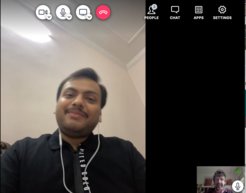Google Summer of Code Student finds software solution for FHI

In the mentorship program Google Summer of Code (GSoC), students from all over the world receive a stipend to spend their summer breaks programming open source software solutions for companies and institutions. This year, the Fritz Haber Institute also participated: Heinz Junkes, head of the IT department, was a mentor in the RTEMS project. For three months, he supervised the Computer Science student Mritunjay Sharma from the JSS Academy of Technical Education, Noida, India (part of Abdul Kalam Technical University).
RTEMS is an open source operating system and stands for Real-Time Executive for Multiprocessor Systems. Heinz Junkes explains how it is being used at the Fritz Haber Institute: "For experiment control and data acquisition, in some places you have to use a suitable operating system in addition to suitable hardware. This is important because experiments always generate new data and events which the operating system must be able to keep up with. Only so-called real-time systems can do this".
Popular operating systems like Windows, MacOS or Linux cannot do this – everyone has experienced 'frozen' computers, which have to be switched off and on again. So in some cases an open source product like RTEMS is needed. Organizations like NASA and ESA for example use RTEMS to operate satellites and equipment in space, because they have to react immediately to changes. At the Fritz Haber Institute RTEMS is used to operate the free-electron laser (FEL), a synchrotron radiation device that can be used to determine atomic structural properties of various materials. With every burst of electrons emitted by this laser, the operating system must be able to spontaneously provide the right excitation for acceleration.

The use of RTEMS is necessarily linked to other programs like control software used to manage large experimental facilities such as particle accelerators, giant telescopes or free-electron lasers. Control software protects the equipment from cyber attacks, (among other things), which could damage the technology and falsify the experimental results. At the Fritz Haber Institute, EPICS is the control software of choice. But using multiple softwares makes it necessary to connect them. "Suitable interfaces must be created between these systems," explains Heinz Junkes, "EPICS and RTEMS must always be compatible with each other.” But even if these interfaces are in place and functioning, they must be reconfigured with each update of the software. Adapting them can be tedious and time-consuming.
The student Mritunjay Sharma was able to solve this problem in his coding project for the Fritz Haber Institute. Of course he first had to learn more about software development on such a project. He spent one month in spring 2020 learning about the special features of RTEMS. In the course of the summer he developed the solution: a Continuous Integrating System (CI). "This is a program that autonomously forms a functional interface between larger software solutions such as RTEMS and EPICS, without the need for on-site IT specialists to assist in the adaptation process," explains Sharma. Mentor Heinz Junkes is enthusiastic: "The result of this project makes a big difference at the FHI," he says, "it saves us a lot of time and effort.”
During his GSoC project, Mritunjay Sharma not only learnt about technical skills like clean coding, writing configuration scripts and understanding the workflow of embedded systems, but also acquired many new soft skills. “I now understand the value of communication and empathy much better, as well as the importance of community building.” In the future, he would like to work on projects of agencies like CERN, ISRO, or NASA, and continue to contribute to open-source communities.
Mritunjay Sharma passed his GSoC project with flying colors. The Fritz Haber Institute congratulates him warmly!

